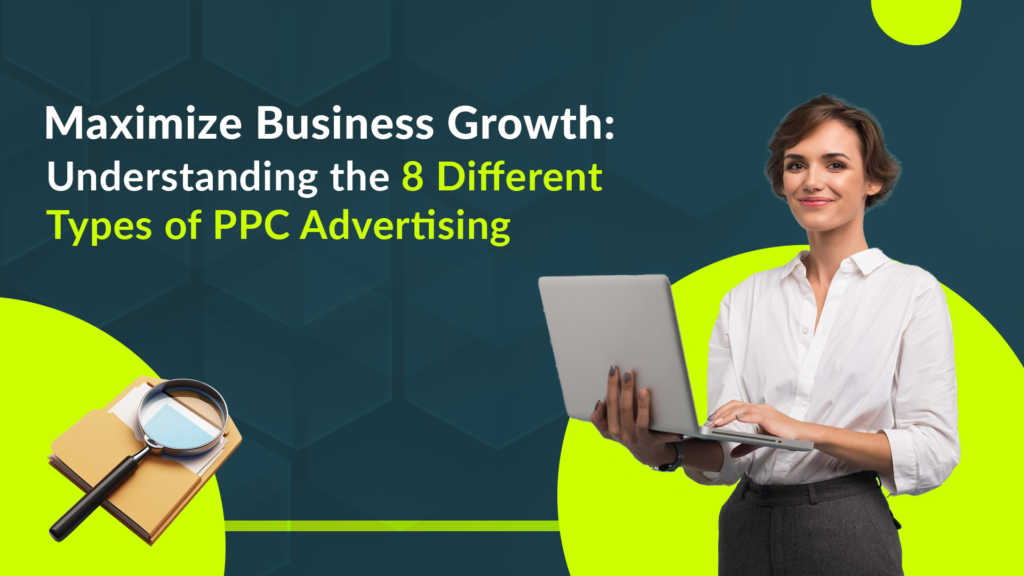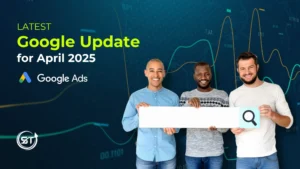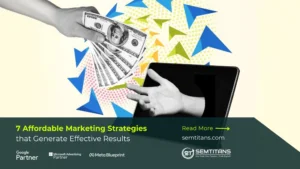
Table of Contents
ToggleTimes have changed, and so have marketing strategies. The digital age has revolutionized how businesses operate and is widely accepted by the masses. Many businesses have seen this change and are using the benefits of the digital platform to promote their businesses, which was difficult earlier. One of the methods of digital marketing strategy today is PPC (Pay-Per-Click).
PPC, which stands for Pay-Per-Click, is an online advertising strategy where advertisers pay each time their ad is clicked. It’s a way to buy visits to your website instead of waiting for people to find it organically. PPC is a fantastic way to target specific visitors to your site and can complement other digital marketing strategies. Below are some of the types of PPC advertising methods:
1. Search Advertising (Google Ads, Bing Ads)
Google Ads is the go-to choose for search engine advertising, as it shows text ads on SERPs like Google, Bing, or Yahoo. Advertisers bid for keywords to show up when users start to search. It can be quite challenging for Google ads due to the high level of competition for top ad placements. Additionally, the constantly changing search trends make it difficult to stay ahead. It is a great way to get noticed by people who are actively looking for what you offer.
When to use:
- To connect with customers who are eager to purchase or learn more about your products or services.
- Have specific keywords related to your business that you want to focus on.
- Want your business to appear at the top of search engine results when people search for similar products or services.
For instance, let’s say you own a pizza restaurant. Search advertising would be perfect for you because when someone searches for “best pizza near me,” your ad could appear at the top of the search results, tempting hungry customers to visit your restaurant. Or
2. Social Media Advertising (Facebook Ads, Instagram Ads, Twitter Ads)
One of the best things about social media marketing is the ability to target specific audiences. Platforms like Facebook and Instagram give advertisers a ton of data to work with, so they can reach their ideal customers based on things like age, gender, location, interests, and behaviors. This kind of detailed targeting means ads are shown to the right people, making them more likely to engage with the content and take action. Ads can show up in users’ news feeds, stories, or other spots on social media platforms.
When to use it:
- If you’re looking to boost brand recognition and expand your reach,
- Launching a new product or service and aiming to create excitement.
- Running a promotion or sale to attract more visitors to your website or store.
- Wanting to connect with your audience and establish relationships with potential customers.
For instance, a local bakery can use social media advertising to promote its new cake line and drive foot traffic to its store.
3. Display Network Advertising (Google Display Network, Bing Audience Network)
Display network advertising enables businesses to showcase banners, videos, or rich media ads across a network of websites, apps, and platforms. These ads can be tailored to target users based on their interests, topics, and browsing behavior. It is all about grabbing people’s attention with eye-catching visuals online.
When to use:
- To increase brand awareness and get your business noticed by a large audience.
- You have visually appealing ads that you want to display on websites, blogs, or apps.
- You want to target specific demographics or interests to reach potential customers.
For instance, a real estate agency could use display advertising to promote listings for properties such as luxury homes or vacation homes, targeting potential buyers or renters on home decor, lifestyle, or travel websites.
4. Remarketing/Retargeting Advertising
Have you ever noticed how, after visiting a website, you start seeing ads for that same brand everywhere you go online? That’s remarketing, or retargeting, in action. It’s a powerful tool that businesses use to reconnect with people who have shown interest in their products or services. By displaying ads to users who have already engaged with their brand, businesses can increase the chances of turning those potential customers into actual buyers. It’s a smart way to boost conversions and keep your brand at the top of consumers’ minds.
When to Use:
- You want to reconnect with visitors who showed interest in your products or services but have not purchased.
- To remind potential customers about your brand and encourage them to return to your website to complete a purchase.
- You have specific offers or promotions that you want to target to people who have already expressed interest in your brand.
For instance, an e-commerce website can display targeted ads featuring discounts or free shipping to visitors who added items to their cart but still need to complete the checkout process.
5. Shopping Ads/Product Listing Ads
Have you ever noticed those ads that show up at the top of your search results with pictures and product prices? Those are called shopping or product listing ads (PLAs). They’re a fancy type of PPC advertising that shows off products in the search results. These ads are particularly effective for e-commerce businesses promoting their products.
When to Use:
- You have an e-commerce store and want to showcase your products to people searching for them online.
- You want to increase visibility for specific products and drive traffic to your online store.
- You are looking for a cost-effective way to reach potential customers who are actively searching for products like yours.
For instance, an electronics retailer can showcase its latest smartphones and laptops with product listing ads that appear when users search for “smartphone deals” or “laptop discounts.”
6. Video Advertising (YouTube Ads, Social Media Video Ads)
Video advertising is a way for businesses to connect with their audience through engaging visual content. It is also a great way for businesses to showcase their products, services, or brand stories through videos on platforms like YouTube, social media, and other video-sharing websites. You can choose between skippable or non-skippable ads, and advertisers only pay when users watch a certain portion of the ad.
When to Use:
- You want to tell a story or showcase your products or services visually compellingly.
- You want to reach a broad audience across various online platforms, including social media, websites, and video streaming services.
- You want to capture viewers’ attention and leave a lasting impression with immersive video content.
For instance, a cosmetics brand can create video ads demonstrating the application of its makeup products and the transformation they offer, targeting beauty enthusiasts on YouTube and Instagram.
7. Mobile App Advertising
Mobile app advertising is a great way for businesses to promote their apps or advertise within other mobile apps. This can involve app install ads, which prompt users to download an app or in-app advertising, where ads are shown within the content or gameplay of an app.
When to Use:
- You have developed a mobile app and want to increase its visibility and downloads.
- You’re looking to engage with users who are actively using mobile devices and apps.
- You want to drive app installs, increase user engagement, and generate revenue through in-app purchases or ad revenue.
For instance, a gaming app developer can use mobile app advertising to promote their new game and encourage users to download and play it.
8. Influencer Marketing
Influencer marketing is all about teaming up with popular individuals or creators on social media to showcase products or services. This type of advertising taps into the trust and credibility that influencers have established with their followers.
When to Use:
- You want to reach a specific target audience by partnering with influencers who have a large and engaged following in your niche.
- You’re looking to build credibility and trust for your brand through authentic recommendations from trusted influencers.
- You want to create buzz and generate excitement around your products or services by tapping into the influence of popular personalities.
For instance, a fitness apparel company can partner with an Instagram influencer to post photos and videos of them wearing the brand’s activewear during workouts, inspiring their followers to purchase the same outfits.
Wrapping Up:
PPC ad types are constantly evolving and expanding across new platforms and technologies. As consumer behavior and technology change, new ad formats and platforms will emerge. This means PPC professionals need to stay updated and adjust their strategies accordingly.












